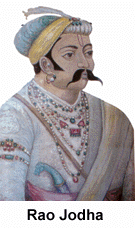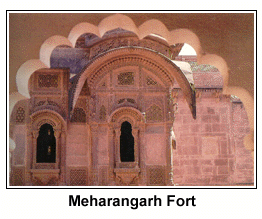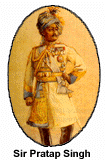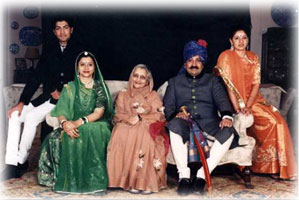
Coat of Arms
|
History of Rathores
|

Coat of Arms |
 |
According to Rathore tradition, the clan traces its origins back to the Hindu god, Rama, hero of the epic Ramayana, and thence to the sun. So the Rathores belong to the Suryavansha (solar race) branch of the Kshatriyas, the warrior caste of Hindus. Later, breaking into historical reality, in 470 A.D. Nayal Pal conquered the kingdom of Kannauj, near modern Kanpur in Uttar Pradesh. The Rathore capital for seven centuries, Kannauj fell in 1193 to the Afghan invader's led by Muhammad Ghori.
The fleeing ruler, Jai Chand, drowned in the Ganga. But his son or grandson, Rao Siyaji, had better luck and Rao Siyaji moved west to the golden sands of the Thar desert. An expedient marriage alliance between the Rathore Siyaji and the sister of a local prince enabled the Rathores to consolidate themselves in this region. In fact, they prospered to such a degree that they managed to oust the Pratiharas of Mandore, nine km to the north of present day Jodhpur. He later set himself up as an independent ruler around the wealthy trading center of Pali, just south of Jodhpur. His descendants flourished, battled often, won often, and in 1381 Rao Chanda ousted the Pratihars from Mandore which then became the Rathore seat of government. Rathore fortunes then turned. Rao Chanda's son and heir, Rainmal, won praise for his capture of Ajmer and was then entrusted with the care of his orphaned nephew, destined to inherit the Mewar throne of Chittor. Rainmal may well have had his eyes on this fine, hilltop fort. But court intrigue and treachery stopped him. In 1438 he was doped with opium, and finally shot dead. This triggered bitter feuds, ending with Mewar and Marwar becoming separate states. Rathore legend continues in various versions. One is that Jodha, one of Rainmal's 24 sons, fled Chittor and finally, 15 years later, recaptured Mandore in 1453. Five years later he was acknowledged as ruler. A holy man sensibly advised him to move his capital to hilltop safety.
 |
By 1459, it became evident that a more secure headquarters was required. The high rocky ridge nine km to the south of Mandore was an obvious choice for the new city of Jodhpur, with the natural enhanced by a fortress of staggering proportions, and to which Rao Jodha's successors added over the centuries.
Situated atop of a rocky hill 125 m. high, the Jodhpur fort was the mainstay of the princes of Marwar. It has massive, mighty walls and lofty gates. It is the city most closely associated with Rajput valour and the desert beauty of Rajasthan.
The palaces within are noted for their lattice work in red sandstone. They are articulate in design and extreme care has been taken in most to ensure that every possible detail is worked into meticulously. Jodhpur is fast growing to be one of the country's most visited and photograped destinations, with tourists returning year after year to see the magnificent monuments and palaces, in this city whose architecture has become a sort of monument to human endeavour.
The district of Jodhpur was known as the ancient kingdom of Marwar the land of Death, the largest kingdom in Rajputana and the third largest of the Indian Kingdoms, after Kashmir and Hyderabad. Jodhpur, former capital of Marwar state, retains much of its medieval character. Beginning in 1549, when the city was called Jodhgarh, the Rathore clan of Rajputs fought and ruled from the virtually impregnable fort until their territory covered some 35,000 sq. miles making it the largest Rajput state.
Although there have been numerous invasions into this territory, the Rajputs managed to ward them off very well. The descendants of Rao Jodha Rathore not only ruled Jodhpur but the entire region of Rajasthan all around. The Rajput kingdom of the Rathores was once known as the land of death and universally accepted as an invincible force.
MEWAR AND THE MUGHULS. Rao Ganga Singh of Jodhpur (reigned 1516-32) fought alongside the army of the great warrior king of Mewar, Rana Sanga, against the first Mughal emperor, Babur. But over the next half century or so, the rulers of Jodhpur allied themselves with Babur's grandson, Akbar. Several rulers of Jodhpur became trusted lieutenants of the Mughals, such as Raja Surender, who conquered Gujarat and much of the Deccan for Akbar, and Raja Gaj Singh, who put down the rebellion of the Mughal prince, Khurram, against his father, Jahangir. With the support of the Mughals, the court of Jodhpur flourished and the kingdom became a great center of the arts and culture. In the 17th century Jodhpur became a flourishing center of trade for the camel caravans moving from Central Asia to the parts of Gujarat and vice versa. In 1657, however, Maharaja Jaswant Singh (reigned 1638-78) backed the wrong prince in the great war of succession to the Mughal throne. He was in power for almost twenty-five years with Aurangzeb before he was sent out to the frontier as viceroy in Afghanistan. Aurangzeb then tried to seize his infant son, but loyal retainers smuggled the little prince out of his clutches, hidden, they say, in a basket of sweets.
Political Strife: The kingdom of Jodhpur then formed a triple alliance with Udaipur and Jaipur, which together threw off the Mughal yoke. As a result, the maharajas of Jodhpur finally regained the privilege of marrying Udaipur princesses something they had forfeited when they had allied themselves with the Mughals. A condition of these marriages, however, was that the sons born of the Udaipur princesses would be first in line to the Jodhpur throne. This soon led to considerable jealousy. Nearly a century of turmoil followed, culminating in Jodhpur falling under the influence of, first, the Marathas, and then, in 1818, the British. The state of affairs was such that a young Rathor prince, when asked ,where Jodhpur was, simply pointed to the sheath of his 'dagger and said, "Inside here".

SIR PRATAP SINGH: In the 1870's, a remarkable man came to the fore in
Jodhpur: Sir Pratap Singh (right). A son of Maharaja of Jodhpur, he himself
ruled a neighboring kingdom called Idar, abdicated to become Regent of Jodhpur,
which he ruled, in effect, for nearly fifty years. Sir Pratap Singh was a great
warrior and the epitome of Rajput chivalry. He became an intimate friend of
three British sovereigns. At Queen Victoria's durbar he is said to have
presented her not with mere jewels, like everyone else, but with his own sword,
his most valuable possession as a Rajput warrior. Sir Pratap Singh laid the
foundation of a modern state in Jodhpur, which Maharaja Umaid Singh (reigned
1918-47) built upon. The state of Jodhpur was not merely the largest of the
Rajput states, but also one of the most progressive. In 1949, after the independence
of India, it was merged into the newly created state of Rajasthan.
|
Ruling family
|

HEAD OF THE SOVEREIGN FAMILY: HH Gajsinghji II Sahib, nicknamed Bapji, Maharaja of Jodhpur since 1952, educ Cothill Preparatory School 1956, Eton and Oxford, °1948, X 19/2/1973 Hemlata Rajye, daughter of Sivraten Deo Singh, Raja of Poonch
CHILDREN:
1Baijilal Shivranjani Rajiye, °1974
2 Yuvraj Shivraj Singh, educ Eton
BROTHERS AND SISTER:
1 Maharaj Dhiraj Himmat Singh
2 Baijilal Rajendra Kanwar, styled HH Maharani Padhma Devi, +1984, X 1950 HH Fateh Singh Rao Gaekwar, 13th Maharaja of Baroda 1951-1/9/1988, +Bombay 1/9/1988, nicknamed Jackie, fmr Indian Min of Health ....-1980, fmr Parliamentary Secretary for Defence (under the name of V.K. Krishna Menon), LtCol in the Cavalry Baroda Lancers Rgt, Chancellor of the Univ of Baroda, Chm of Baroda Rayon Corp 1956, Dr in Literature, °1930, +Bombay 1/9/1988
3 Maharaj Hari Singh
4 Maharaj Devi Singh
5 Maharaj Dalip Singh (Fort Chanwa, Luni, Rajasthan).
Father of:
5.1. Rajkumar Virvikram Singh, °1967, X Yamini, °Uttar Pradesh,
daughter of ... and adopted by Rani Usha Devi
UNCLE:
Son of Maharaj Ajit Singh, brother of HH Maharaja Umaid Singh:
1 Maharaj Shobhag Singh, mbr of the Rajasthan State Assembly. Father of:
1.1 Rajkumar Ranvijay Singh
1.2 Rajkumar Karanvijay Singh
2 Maharaj Swaroop Singh, mbr of the Pakistani Parliament 1962 then MP in
New Delhi and also mbr of the Rajasthan State Assembly, Gen Man of the Ajit Bhawan at
Jodhpur, founder of the Heritage Hotels Assn, X Usha Devi, °..., Himachal Pradesh.
Father of:
2.1 Rajkumar Raghuvendra Singh Rathore, nicknamed Ragu, fashion
designer, dipl Parsons School of Design, New York
2.2 Rajkumar Suryaveer Singh Rathore, nicknamed Chotu, °1972, X
5/1997 Uttara Kumari, °1976
| Famous monuments |
| Mehrangarh Fort Situated on a steep hill, Mehrangarh fort is one of the largest forts in India. The fort has been a witness to the splendour of a bygone era. The beauty and the grandeur of numerous palaces in the fort narrates a saga of hard sandstones yielding to the chisels of skilled Jodhpuri sculptures. To enter the fort seven gates have to be crossed. Some of these gates still bear marks of numerous siege which this fort withstood. Its very hard to imagine how any invader even thought of conquering this fort which at places has 17 feet thick and 68 feet high walls.
Within the palace inside the Fort are rooms with rich collections of palanquins, elephant howdahs, musical instruments, costumes, furniture and armoury. The display of canon here is one of the rarest in India. The fort was built around 1459, when the Rajput king, Rao Jodha shifted his capital here from the nearby Mandore. The Mehrangarh fort encloses many palaces which are known for their intricate carvings and sprawling courtyards. Moti Mahal or the Pearl palace has a delicately carved stone screen and treasures the Sringar Chowki, royal throne of Jodhpur. Umaid villas displays the Rajput miniature paintings and Ajit villas exhibits musical instruments and the royal costumes. Both these villas are joined by a beautiful mirror room.
The Jodhpur coat of arms is kept in the Phool Mahal. Walls of this Flower palace is covered with paintings depicting various musical moods. The Maan villass displays Rathore armoury and the 'Tent room'. This tent room is an imperial Mughal campaign tent, used by Shahjahan but wrested by Jaswant Singh from Aurangzeb in a battle. Made of red velvet and embroider with gold thread, it gives some idea of the grandeur with which the Mughals approached even their battles. The fort is most associated, however, with the famous Rajput king, Raja Man Singh, who became the biggest Rajput regent in the post-Mughal era. The fort is known for its magnificent doorways, one of which has several handprints of women. These are prints of those women who died with the funeral pyre of their husbands, under an ancient Hindu custom of Sati. Man Singh is credited with an amazing 15 such prints! |
||
|
Jaswant Thada This is another of the fantastic structures one can hope to come across only in Rajasthan. The white marble memorial was built in 1899 in memory of Maharja Jaswant Singh II. The entire monument is built out of sheets of marble so thin that sunlight can filter through it in gentle rays. There are also two more tombs inside the structure. |
||
|
Umaid Bhavan Palace The Umaid palace is probably one of the most talked about and visited structures in Rajasthan. This huge palace was built by Maharaja Umaid Singh, the president of the British Royal Institute of Architects was specially commissioned to work on it. It was completed just four years before independence, and hardly saw any inhabitance from royal families. Most of the hotel has now been converted into a swank five-star hotel, though you can get in and look around without having to stay here. |
||
|
The museum here has the usual trappings of a city museum, containing exhibits of armoury, textiles, local arts and crafts, miniature paintings. Being in a place with a history as vibrant as that of Jodhpur, there is obviously a lot of interesting tit bits to gather from around here. |
||
| The Mahamandir Temple This templs is the most important Hindu temple in these parts. It is supported by 100 pillars and has carvings depicting yoga postures. Balsamand |
| Excursions |
Mandore
Mandore, just 20 mins away from Jodhpur, used to be the capital of the Rajput kingdom of
Marwar till Rao Jodha set base at Jodhpur with his Mehragarh fort. The gardens here,
coupled with their huge rock terraces are a major attraction here. There are also
cenotaphs here, in the memory of the local leaders, the most impressive of which is the
temple-shaped memorial to Maharaja Ajit Singh.
However, the highlight of Mandore is the Hall of Heroes, which houses 16 gigantic figures chiselled out of one single rock.
Sardar Samand
A lot like the palace and temple at Balsamand is the more imposing equivalent, the Sardar
Samand lake and palace. It is about 55 km. from Jodhpur, an extremely interesting drive,
with plenty of interesting people to be seen, good spots to photograph. Invariably, your
drive will be pleasantly halted by hordes of crossing Black bucks and Chinkaras.
Dhawa Wildlife Sanctuary
The Dhawa sanctuary is interesting not only because of the variety of black buck, deer and
chinkaras found here, but also because of the interesting tribe that inhabits these parts,
the Bishnois.
There is little or no poaching in here because the Bishnois worship everything that is living, and consider it a crime to kill animals. This applies not only to themselves but to everyone on their lands.
Consequently, they are extremely protective of the animals here and will not let poachers anywhere near. This is also the only place where you can see Indian antelopes roaming freely in such numbers.
Osian (65 km).
Osian was an important ancient city of Hindus and Jains, this used to be the cradle of
Rajasthani art. When the first Muslims invaded, they routed the city, and razed quite as
much as they could. All that remains now are the ruins of the ancient city. There are now
only 16 Hindu and Jain temples dating from the 8th to 11th centuries.
Nagaur (135 km)
Nagaur with its massive ramparts and impressive gateways is one of the fascinating
towns of Rajputs. The town was ruled by Raja Amar Singh Rathore. The historic
Nagaur Fort houses splendid palaces, temples and palatial mansions. Some of
thr beautiful palaces within the fort including Moti Mahal, Badal Mahal and
Hawa Mahal are all splendid architectural creations. The courtyard or Baradari
has painted walls, adorned with some exquisite frescoes and lovely murals which
are a blend of the persian and the typical Nagaur styles. The distinctive highlights
of Nagaur's temples are the decorated walls and entrances, ornate with beautiful
paintings depicting various episodes from the Ramayana and Mahabharata. The
paintings in the Jain temples, depict motifs related to the life of Lord Mahavir
and Parsavnath. The 'Tarkin ka dargah' is a noteworthy 15th centuary mosque
worth visiting. Nagaur is the venue of an annual cattle fair held in Jan/Feb.
During the four day festival, the town is thronged by cows, bullocks, oxen and
camels accompained by turbaned sellers and eager buyers. Cock and bull fight,
camels races, flok dances and music enhance the excitement of the fair.